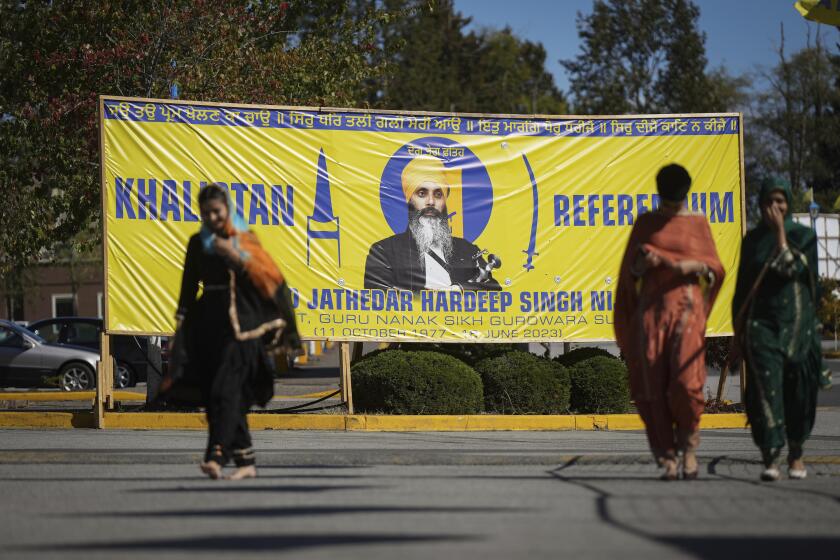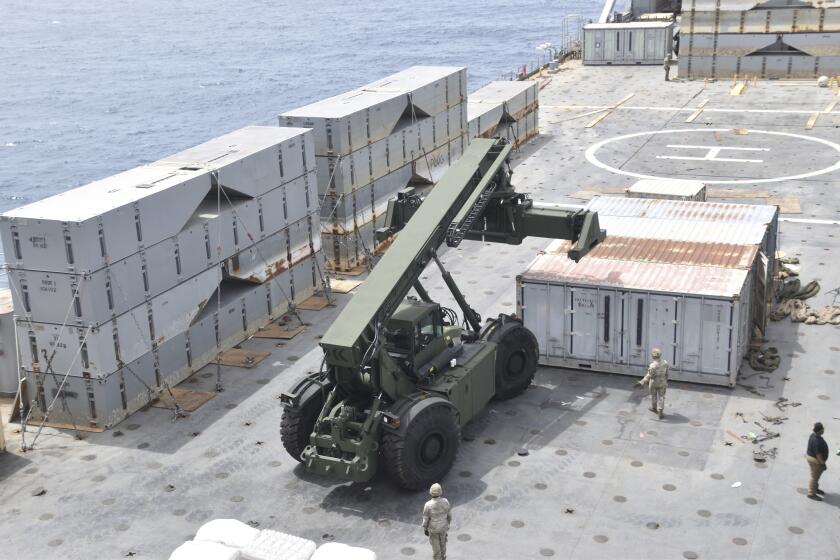Grief, Disarray on Gandhi’s Last Journey : India: Train ride with the leader’s ashes spotlights political and religious crisis.
The Sacred Ashes Special pulled into Kanpur railway station late Monday night to the same slogans that had bombarded Sonia Gandhi again and again during the 10 hours that her train, carrying the remains of her assassinated husband, had snaked its way through the blistering Indian countryside.
“Sonia, fight! Save the nation!” mob after screaming mob had pleaded when they spotted the white, garlanded shrine car. Inside, Sonia Gandhi sat on the floor, on a bare white sheet, beside the flower-decked pedestal that held the copper urn containing her husband’s ashes.
Eleven hours on from Kanpur, the train’s journey ended Tuesday, in a shower of ashes, rose petals and tears, as Rajiv Gandhi’s remains were strewn to his gods at the confluence of the sacred rivers Ganges and Yamuna.
But it was here in Kanpur late Monday night, halfway through that 21-hour odyssey, that so many of India’s recent nightmares intersected; here that living symbols of India’s innumerable problems made the 18-car special train a stark metaphor of national crisis.
First, there was the political crisis: Two cars behind where Sonia Gandhi sat with her son Rahul, daughter Priyanka and a handful of personal friends was the entire leadership of Gandhi’s disheveled Congress-I Party. Most of them were sleeping then, but a few cringed at the shouted campaign slogans for a party leader with the right name who simply will not take the job; the rest quietly pondered today’s meeting in New Delhi, where they will reluctantly select an interim president who has little or no national standing.
There was also, of course, Sonia Gandhi’s grief: She wept here for the first time since the train left New Delhi, when a group of widows, clutching their children, filed past her car, their faces smeared with tears and their frantic fingers shoving rose petals through the barred but open windows.
And then there were symbols of past, present and future horrors: Hundreds of soldiers on guard with automatic rifles, grim reminders of the religious hatred that claimed more than 20 lives here the night before Rajiv Gandhi was killed by a suicide bomber May 21.
That violence was why Mehroon Nisa and many like her could not join the widows who greeted Sonia Gandhi all along her route. Nisa, like many thousands of other Indians, was far too busy with her own nightmare to share the Gandhis’.
Just 24 hours before Gandhi was killed at an election rally near the southern city of Madras, Nisa’s eldest daughter had been kidnaped, raped, stabbed and burned to death--a victim of the religious and political violence that has been tearing India’s national fabric to ribbons in recent months.
“At the moment, personal crisis has overtaken me. I have brought up my daughter after so much sacrifice, and this is what becomes of her,” Nisa, 40, whose husband died of throat cancer five years ago, told a visitor to her Kanpur home the morning after Gandhi’s ashes had moved on out of town. “So my personal tragedy has made it impossible to feel anything more for Mrs. Gandhi--for anyone. I didn’t even know the ashes were coming here.”
And yet, it was Mehroon Nisa and the millions of impoverished Muslims like her here in the vote-rich northern Hindi belt that the men in the second car down from Sonia Gandhi’s were trying to reach.
In Kanpur and so many towns on the route of the ashes, Congress-I leaders were attempting to use what little was left of Rajiv Gandhi to fuel a wave of sympathy that would return their party to power at the polls next month.
But it is a wave that simply will not rise in much of the nation, at least not without Sonia Gandhi at the party helm, according to dozens of men and women interviewed along the route of the train.
The picture that emerged from among the smaller-than-expected crowds along India’s Grand Trunk Railway on Monday and Tuesday, and from among those who did not come, is of a nation numbed by violence, fearful of the future and desperate for a nonexistent savior; a new sense of despair is seeping to the roots of what has been the world’s most vibrant and largest democracy.
But that was a picture all but missed by the 40 or so Congress-I leaders, who ventured just a few feet from their air-conditioned club car throughout the journey and rarely spoke to anyone in the mourning crowds.
In an interview inside his compartment on the Sacred Ashes Special, P. V. Narasimha Rao, the man most likely to be named Congress-I president today, said the leaders are confident the party will be swept back to power on the wave of sympathy next month.
“The momentum that has been built is going to see the party through,” said the 70-year-old leader, referring to the front-running campaign Gandhi was waging before his death.
Referring to the crowds at stations along the route, he added: “You can see the real significance in their faces. The people: What are they are seeing? They are only seeing an urn? No one sees just a pot. They conjure an image that is of something else.
“People don’t come all this distance to look at an urn and then go back and vote against the Congress.”
But outside the party leaders’ car, there was a far different mood.
In Khurja, a whistle-stop 90 minutes out of New Delhi, Hargyan G. Sharma, a state planning department employee, spoke tearfully of “the great tragedy that has befallen the country.” He said Gandhi’s loss has left a void not only in the party but in the nation, which only his widow can fill.
“If Narasimha Rao comes as party president,” said Sharma, who described himself as a staunch Congress-I supporter, “definitely there will be a split.”
Standing nearby, perspiring in the 102-degree noon heat, Harpal Singh Nagal, 40, was blunter about the deep desire at Congress-I’s grass roots to see continuation of a dynasty begun with Jawaharlal Nehru, carried on by his daughter Indira Gandhi, and then her son, Rajiv--even if it means taking on a woman born Italian and Roman Catholic to lead a nation that is overwhelmingly Hindu.
“The sympathy toward the Gandhi family will be there only as long as the Gandhi-Nehru family is with the party. It doesn’t go beyond the family,” Singh said. “I tell you very confidentially, if the family is there, the Congress is there. The survival of party is linked to survival of the family, which is linked to the survival of the nation.”
That sentiment proved stronger as the train inched from town to town toward Allahabad, the sacred place where Rahul Gandhi scattered his father’s ashes Tuesday from the same spot that Rajiv and his brother Sanjay had scattered their grandfather Nehru’s three decades earlier.
In the town of Etawah--where there was so much bloodshed and intimidation on the first day of polling, the day before Gandhi’s assassination, that local authorities annulled and postponed the voting--Push Pawar nodded toward students who had come to see the train: “You see all these boys here? If Sonia doesn’t come, all of them will vote BJP.”
BJP is the Bharatiya Janata Party, an ultranationalist, right-wing Hindu revivalist party that has promised to deliver India its first Hindu government if it wins the election. Its campaign has been built largely around a well-organized religious crusade to build a temple to the Hindu divinity Rama, on the site of an ancient mosque in the state of Uttar Pradesh.
So powerful has been the revivalists’ appeal in Uttar Pradesh that Congress leaders in the train’s club car conceded that before the election they had almost written off the state’s 85 parliamentary seats--the most of any of India’s 22 states.
Kanpur is a place that knows that passion. As the Gandhi train pulled out of the station, it left behind a grief-stricken city of nearly 1 million--pockets of it still under curfew--that knows the BJP all too well.
Most of the Hindus in town, the majority, still support the BJP with fervor. All the Muslims, present here in larger proportion than in most of India, will do anything, even kill, to stop the party.
So it is in Chamanganj, a Muslim district that was one of the worst-hit in the recent religious violence. It is in this neighborhood of crumbling, narrow lanes and open sewers whose name means “the place of gardens” that Mehroon Nisa lives in a courtyard with her extended family.
Local Muslim elders explained how Nisa’s daughter had come to be the focal point of much of the death in Kanpur:
It began two nights before Gandhi’s assassination in the midst of election violence that left more than 200 dead nationwide. A truck escorting about 200 BJP workers, all of them shouting “Muslims, India will be your graveyard!” as they drove through the city’s largely segregated residential areas, accidentally ran over and killed an elderly Muslim woman.
A crowd of angry Muslims set upon the driver and beat him to death.
The following day, Seema Begum, Nisa’s daughter, had to pass through a Hindu neighborhood on her way home to a day-after-marriage ritual known as chauthi. She was escorted by her brothers and uncles, but a Hindu mob, bent on revenge for the driver’s death, stabbed her brothers and an uncle and took her away, laden with the simple jewelry that were her wedding gifts.
“After that, everyone was in the streets shouting, ‘Bring back Seema,’ and, of course, that’s when the riots started. It only got worse when they found her burned body the following day,” an elder said.
Nisa wasn’t weeping as she filled in the details Tuesday morning. She had cried for days, she said, and only now was beginning to realize the enormity of events that had taken place in the nation.
But even now, she said, it is not the death of a Gandhi that will move her at the polls, where she recognizes “a single vote means victory or failure.”
What will decide her vote, she said, is the real reason her eldest daughter was killed:
“It is all a matter of a fight over a mosque, which has now come down to our houses so far away. And now, it is destroying our lives. This is what’s behind it all.”
More to Read
Start your day right
Sign up for Essential California for news, features and recommendations from the L.A. Times and beyond in your inbox six days a week.
You may occasionally receive promotional content from the Los Angeles Times.






